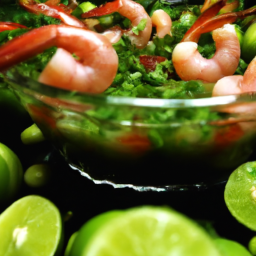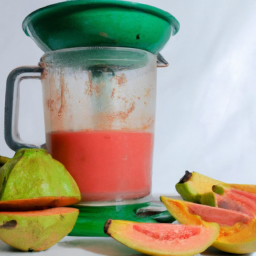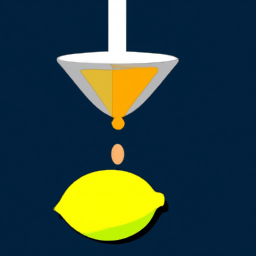Hello, fellow food enthusiasts! Today, I can’t wait to show you my tried and true method for juicing key limes.
As someone who loves adding a tangy twist to my dishes and beverages, key limes are a staple in my kitchen. However, juicing them can be quite a challenge, especially if you’re not familiar with the process.
But worry not, because with a few simple steps, you can easily extract the juice from these tiny citrus fruits and add some zing to your meals and drinks.
In this article, I’ll guide you through the process of choosing the right key limes, preparing them for juicing, selecting a juicing method, and storing your freshly squeezed juice.
So let’s get started and discover the joys of juicing key limes!
Key Takeaways
- Choosing the right type of key limes (Mexican or Tahitian) is important for ultimate flavor.
- Popular juicing methods include hand juicing, citrus press, manual citrus juicer, electric juicer, blender, and food processor.
- Removing seeds and straining the juice through a mesh strainer can improve the flavor and texture of the juice.
- Adding sweeteners like agave nectar or honey, a pinch of salt, and storing the juice away from strong odors can enhance the flavor and freshness of the juice.
Choose the Right Key Limes
You’ll want to pick out the juiciest and most fragrant key limes you can find for the ultimate tart and zesty flavor in your juice!
There are actually two types of key limes: Mexican and Tahitian. Mexican key limes are smaller, have a stronger flavor, and are more commonly found in grocery stores. Tahitian key limes are larger, less acidic, and have a milder flavor.
When looking for the best places to buy key limes, you can typically find them at your local grocery store or farmers market. Look for key limes that are firm to the touch and have a smooth, bright green skin with no blemishes or soft spots. Avoid any key limes that are shriveled or have a yellow tint.
Now that you have your key limes, let’s move on to preparing them for juicing.
Prepare Your Key Limes
Grab a handful of these tiny, green orbs and give them a gentle squeeze to check for ripeness. You want to choose key limes that are firm, heavy, and have a smooth skin. Avoid key limes that are soft, spongy, or have brown spots.
Once you’ve selected your key limes, it’s time to prepare them for juicing. To prepare your key limes, you’ll need the best equipment. A citrus reamer or a handheld juicer works well for juicing key limes. Cut the key limes in half crosswise, and then hold one half over the juicer. Squeeze the lime with your hand and twist it slightly to release the juice. Repeat with each half of the key limes until all the juice has been extracted.
Now that you’ve prepared your key limes, it’s time to choose your juicing method and start making delicious key lime juice!
Choose Your Juicing Method
There are various options available for extracting the tangy, citrusy flavor of these small, green fruits, each with their unique benefits and drawbacks. When it comes to choosing your juicing method for key limes, you will want to consider both juice quality and time efficiency. Here are some popular methods to consider:
| Juicing Method | Advantages | Disadvantages |
|---|---|---|
| Hand Juicing | Low cost, Simple, Easy to control pulp | Time-consuming, Low yield |
| Citrus Press | High yield, Consistent juice quality, Fast | Expensive, Bulky |
| Manual Citrus Juicer | Affordable, Portable, Easy to clean | Inconsistent juice quality, Low yield |
| Electric Juicer | High yield, Fast, Easy to use | Expensive, Bulky, Difficult to clean |
Hand juicing is a classic way to extract juice from key limes. While it may take more time and effort, it allows for greater control over the amount of pulp that gets into the juice. However, if you are looking for a quicker and more efficient way to juice key limes, you may want to explore other methods such as a citrus press or electric juicer.
Hand Juicing
Squeezing the small, tart fruits with your bare hands is a classic and hands-on way to extract their zesty flavor. Hand juicing has its benefits and drawbacks, but it’s an ideal method if you only need a small amount of juice. Here are a few tips on how to hand juice key limes:
-
Start by rolling the limes on a hard surface to soften them up. This’ll make it easier to extract the juice.
-
Cut the limes in half crosswise, not lengthwise. This’ll allow you to get the most juice out of them.
-
Hold the lime half in one hand over a bowl or measuring cup and use your other hand to squeeze it firmly. Use your fingers to press and twist the lime to extract as much juice as possible.
-
Strain the juice through a fine-mesh sieve to remove any seeds or pulp.
Although hand juicing is a simple and inexpensive method, it can be time-consuming and may not yield as much juice as other methods. If you need to juice a large amount of key limes, using a citrus juicer may be a more efficient option.
Using a Citrus Juicer
To extract juice efficiently and effectively, I highly recommend using a citrus juicer. This handy kitchen gadget can simplify the process of juicing key limes and save a lot of time.
Citrus juicers are specifically designed to extract the maximum amount of juice from fruits like key limes, lemons, and oranges. They work by pressing the fruit against a rotating cone, which separates the juice from the pulp and seeds.
When using a citrus juicer, it’s important to follow some cleaning tips to ensure that the juicer stays in good condition. After each use, rinse the juicer with warm water and use a soft brush to remove any pulp or seeds that may be stuck inside. It’s also essential to disassemble the juicer and clean each part thoroughly before storing it.
Citrus juicer maintenance is crucial for the longevity of the gadget and for getting the most out of your juicing experience.
Now that you know about using a citrus juicer, let’s move on to the next section about using a blender or food processor to juice key limes.
Using a Blender or Food Processor
Alright, when using a blender or food processor to juice key limes, there are a few important steps to follow.
First, I always cut my limes in half before adding them to the blender. This makes it easier for the blender to break down the fruit and extract the juice.
Next, I make sure to remove any seeds from the limes before adding them to the blender.
Finally, I simply add my limes to the blender or food processor and blend until smooth.
It’s a quick and easy way to get fresh lime juice for all your culinary needs!
Cut Your Limes in Half
First, grab a sharp knife and cut your key limes in half. Before you start, make sure to practice knife safety by keeping your fingers away from the blade and placing the lime on a stable surface.
Once you have cut the lime in half, you’re ready to start juicing! To make sure you get the most juice out of your limes, try these tips:
- Use a citrus reamer or juicer to help extract the juice.
- Squeeze the lime halves with your hands to get any remaining juice out.
- Gently roll the lime on a countertop before cutting to help break up the pulp and make juicing easier.
Now that you have cut your limes in half and have some juicing tools on hand, it’s time to remove any seeds and start extracting that delicious juice.
Remove Any Seeds
Now that we’ve got our limes cut in half, the next step is to remove any seeds. This is an important step because seeds can add a bitter taste to the juice and can clog up your juicer or blender. There are several seed removal techniques you can use depending on the equipment you have available.
If you have a citrus juicer, simply place the cut half of the lime face down on the juicer and press down. The juicer will extract the juice and remove any seeds at the same time. If you don’t have a juicer, you can use a spoon to scoop out any visible seeds before juicing. Alternatively, you can also strain the juice after juicing to remove any remaining seeds.
Now that our limes are seed-free, it’s time to move on to the next step: juicing! To juice the limes, there are several alternative methods you can use depending on the equipment you have available. If you have a citrus juicer, simply place the seed-free limes on the juicer and press down to extract the juice.
If you don’t have a juicer, you can also use a handheld citrus squeezer or a fork to manually juice the limes. Another option is to add the limes to a blender or food processor and blend until smooth, then strain the juice using a fine mesh strainer.
Now that we know how to remove the seeds and juice the limes, let’s move on to the next step of adding them to our blender or food processor.
Add Your Limes to Your Blender or Food Processor
Once your lime halves are seed-free, it’s time to toss them into your blender or food processor and give them a whirl to create a zesty and refreshing addition to your recipe.
When it comes to choosing between a blender or food processor for juicing key limes, it’s important to consider the desired texture and consistency of your juice. A blender will create a smoother and creamier juice, while a food processor will give you a slightly chunkier texture.
If you prefer your key lime juice to be on the sweeter side, this is the time to add any sweeteners to your blender or food processor. Agave nectar and honey are popular choices to balance out the tartness of the key limes.
Once you’ve blended your key limes to your desired texture and sweetness, it’s time to move on to the next step: straining your juice to remove any remaining pulp or seeds.
Strain Your Juice
To strain your key lime juice, simply grab a mesh strainer and hold it over a bowl before pouring the juice through it. This step ensures that any pulp or seeds are removed from your juice, giving it a smooth, consistent texture.
There are different straining techniques you can use, such as using a cheesecloth or a fine-mesh sieve, but a mesh strainer is the easiest and most efficient method.
The benefits of fresh juice are undeniable, but having a smooth and pulp-free juice can elevate the taste and texture of your drink. Straining your juice also makes it easier to mix with other ingredients or to use in recipes.
Once you have strained your key lime juice, you can move on to storing it in the fridge or freezing it for later use.
Store Your Juice
Now that I’ve strained my key lime juice, it’s important to store it properly to ensure it stays fresh.
I usually refrigerate my juice in a glass container with a tight-fitting lid to keep it chilled and prevent any outside flavors from seeping in.
If I have leftover juice that I won’t be using within a few days, I freeze it in an ice cube tray so I can easily pop out a cube or two whenever I need it.
Refrigerate Your Juice
Surprisingly, the best way to ruin your perfectly juiced key limes is by leaving the juice at room temperature instead of refrigerating it. Refrigeration is key to maintaining the freshness and quality of your key lime juice.
Not only does refrigeration extend the shelf life of your juice, but it also helps preserve its flavor and nutritional benefits. To get the most out of your key lime juice, it’s recommended to refrigerate it for up to 7 days.
This will ensure that your juice stays fresh and flavorful. When refrigerating your juice, make sure to store it in an airtight container to prevent oxidation and contamination. Additionally, keep your juice away from other foods with strong odors to avoid flavor transfer.
With your key lime juice refrigerated and ready to use, the next step is to freeze it for later use.
Freeze Your Juice
Freezing your key lime juice is a great way to ensure that you always have fresh juice on hand. Not only does it preserve the tangy taste, but it also allows for creative uses beyond just adding it to drinks.
One of the benefits of freezing lime juice is that it can be used in various recipes, from marinades to sorbets. By freezing the juice in ice cube trays, you can easily grab a cube or two whenever you need it.
Additionally, freezing the juice is a great way to prevent it from going bad before you have a chance to use it. As you begin to experiment with freezing your lime juice, there are a few tips and tricks to keep in mind.
Tips and Tricks
To make juicing key limes easier, you can try rolling them on the counter or microwaving them for a few seconds before cutting them in half. Here are some more tips and tricks to help you get the most out of your key limes:
- Use a citrus reamer or juicer to extract the juice more efficiently.
- Strain the juice through a fine mesh sieve to remove any seeds or pulp.
- Add a pinch of salt to enhance the flavor of the juice.
- Store the juice in an airtight container in the refrigerator for up to a week.
By following these tips and tricks, you can ensure that you get the most out of your key limes and enjoy the many benefits of key lime juice.
From making delicious cocktails and marinades to adding a tangy twist to your favorite recipes, there are countless ways to incorporate this versatile ingredient into your cooking. So go ahead and start juicing – you won’t be disappointed with the results!
Enjoy Your Freshly Juiced Key Limes!
Once you’ve extracted the tangy, flavorful juice from these small, yellow-green fruits, you can enjoy their bright and zesty taste in a variety of ways.
One creative use for key lime juice is to add it to your favorite cocktail recipe. It pairs especially well with tequila in a classic margarita, or with vodka in a refreshing gimlet. You can also mix it with soda water or tonic for a non-alcoholic spritzer.
In addition to their delicious flavor, key limes also offer several health benefits. They’re a great source of vitamin C, which can boost your immune system and help prevent colds and other illnesses. They also contain antioxidants, which can help protect your cells from damage caused by free radicals.
So next time you juice a batch of key limes, feel good knowing that you’re not only adding a burst of flavor to your recipes, but also giving your body a healthy dose of nutrients.
Frequently Asked Questions
Can I use regular limes instead of key limes for juicing?
Oh, using regular limes for juicing instead of key limes? Sure, if you want your drink to taste like it was made with a dirty sock. Key limes have a unique flavor that can’t be replicated.
How long will the juice of key limes stay fresh?
I store my freshly squeezed key lime juice in a sealed container in the refrigerator. The juice usually stays fresh for up to a week, but it’s best to use it within a few days for optimal flavor.
Are there any health benefits to drinking key lime juice?
Drinking key lime juice has numerous health benefits due to its high vitamin C content and other key lime nutrition. Citrus fruits are known to support immune function, aid digestion, and reduce inflammation.
Can I use the leftover pulp from juicing for any other recipes?
Yes, the leftover pulp from juicing key limes can be used in various creative ways. It can be added to smoothies, marinades, dressings, or even used as a topping for yogurt or oatmeal. Get creative and experiment with different recipes!
Should I remove the seeds from the key limes before juicing?
To ensure smooth and seed-free juice, I recommend using a citrus juicer or straining the juice after squeezing manually. Seed removal techniques vary, but cutting the lime in half and using a spoon works well.
Conclusion
Well, there you have it – a comprehensive guide on how to juice key limes!
With the right limes, preparation, and juicing method, you can have fresh, delicious juice in no time. Whether you choose to hand juice or use a citrus juicer, the key to success is to strain your juice and store it properly.
But wait, there’s more! If you’re feeling adventurous, try using your key lime juice in cocktails, marinades, and even desserts. The possibilities are endless, and with your newfound juicing skills, you can impress your friends and family with your delicious creations.
So go forth and juice those key limes – trust me, the results are worth it!
Ilana has been a vegan for over 10 years. She originally made the switch for health reasons, but soon found herself becoming more and more passionate about the ethical and environmental implications of a vegan lifestyle. Ilana is the author of The Graceful Kitchen, a blog all about veganism. She loves to cook up delicious and nutritious vegan meals, and share her recipes with others who are interested in leading a cruelty-free life. Ilana is also a strong advocate for using whole foods as the foundation of a healthy diet, and believes that going vegan is one of the best ways to achieve this.










